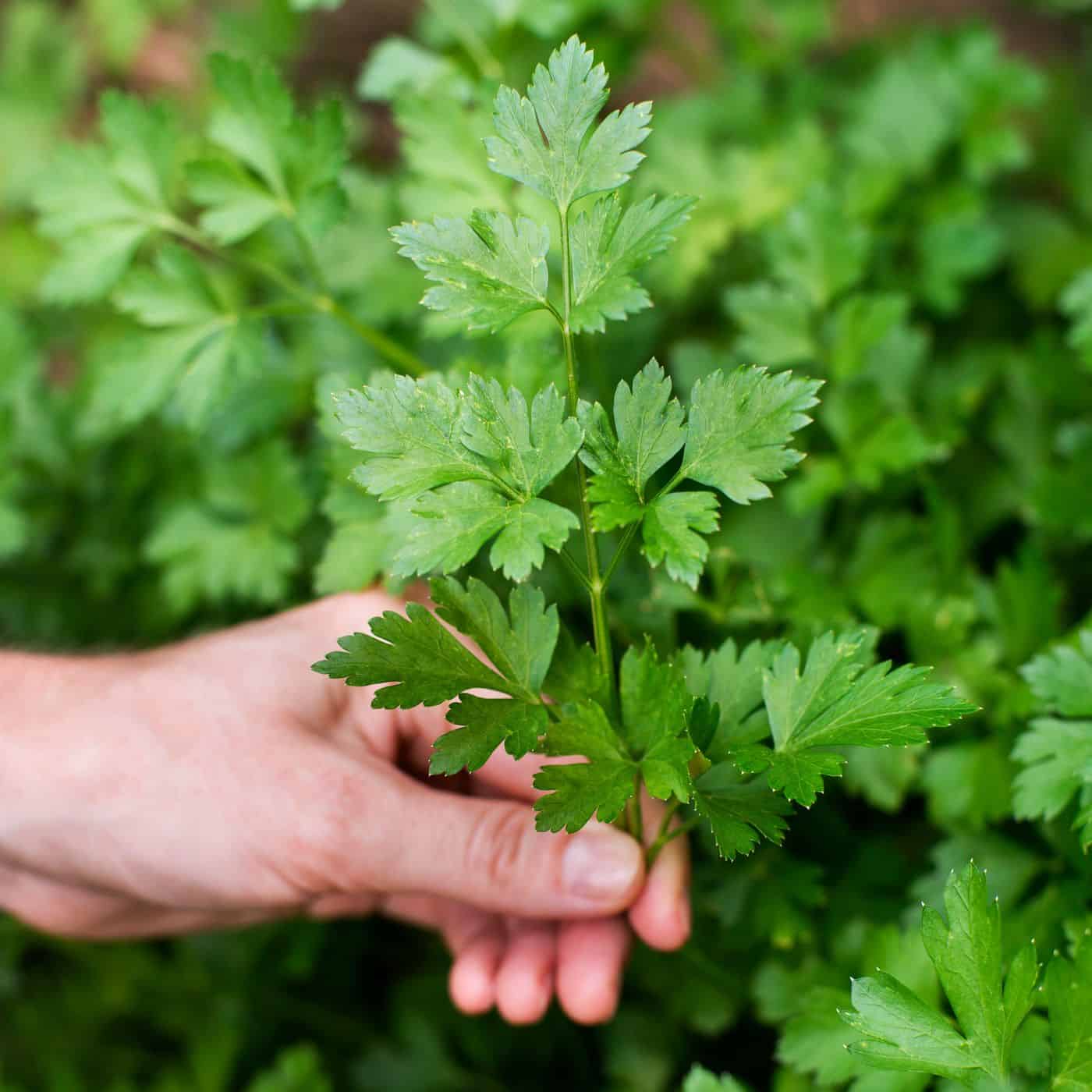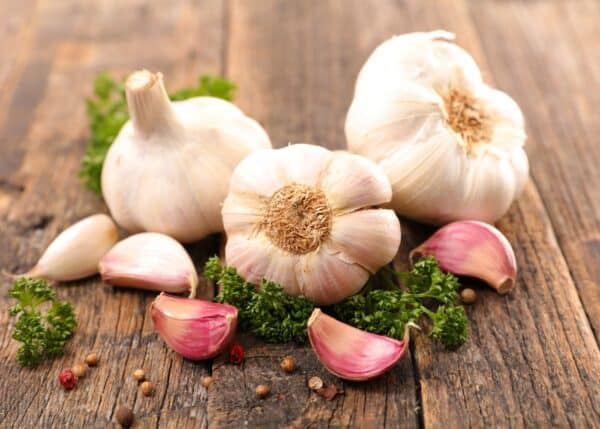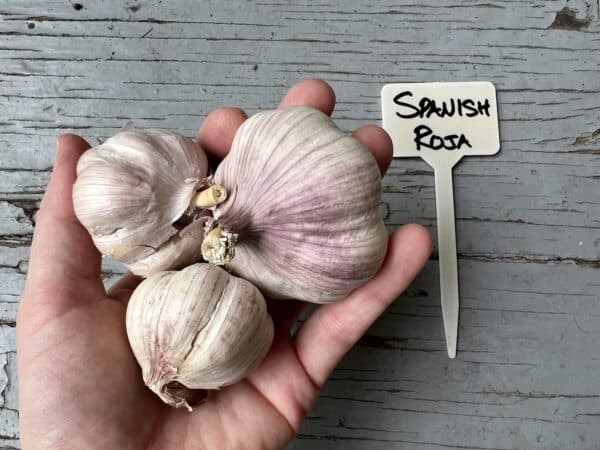When you’re starting a herb garden, parsley is one herb that has to be on the list. I used to view it as the sprig of green garnish on a dish that you could largely ignore, but its unique flavor and versatility make it essential in both the garden and the kitchen. Fortunately, it’s easy to learn how to grow parsley!
To grow parsley, start with a seedling plant for the quickest results. It requires a decent amount of sunlight for strong stems and soil that drains well. Harvest regularly to improve growth and pinch off blooms that negatively impact flavor. You should be enjoying your harvest in a little over two months after planting. Parsley is primarily grown as a biennial, growing for two seasons before it needs to be replaced for optimal flavor.
About parsley
The scientific name of garden parsley is Petroselinum crispum, a member of the Apiaceae family related to celery and carrots.
The genus name Petroselinum originates from the Greek petroselinon, meaning ‘rock-celery’. Like many other herbs, it is indigenous to the Mediterranean but has spread worldwide to become the common garden addition it is today.
In many climates, parsley is grown as a biennial plant, forming a dense set of leaves in the first year and flowering in the second year. As the flavor of the leaves diminishes after flowering, many gardeners prefer to grow parsley as an annual, but you can allow the plant to flower to save the seeds if you prefer.

Parsley varieties
The two main parsley types grown in home gardens are Italian parsley (or flat-leaf parsley), and curly parsley. Curly is the one you may recognize as restaurant garnish, while Italian parsley looks more similar to cilantro in leaf shape.
When you’re growing parsley for cooking (which is what most choose to grow it for), I would opt for Italian parsley as it typically holds the most flavor. Curly parsley does have a little more ornamental value in the garden but doesn’t taste as great, especially when cooked.
Planting parsley
Parsley is grown from seeds or seedlings. Starting from seeds can be a bit challenging as parsley seeds have a hard outer shell and may take a few weeks to germinate. But starting from seed does ensure the plants quickly acclimatize to your garden environment.
If you do choose the seed route, it’s recommended to soak the seeds in warm water before planting. As an impatient gardener, I tend to prefer purchasing seedlings or starter plants instead, but whichever you choose is up to you.
Where does parsley grow best?
When grown as an annual, parsley can be grown in most USDA Zones during the warm months. It prefers locations that get at least six hours of sunlight each day, but it can tolerate partial shade if you’re happy to sacrifice a little leaf growth. A site with well-draining soil is essential to stop the stems and roots from rotting.

Can you grow parsley indoors?
While parsley is often recommended as a herb to grow indoors, I believe it is far better suited to outdoor growth. Every time I’ve tried to keep parsley indoors, it has quickly yellowed, put out very few new leaves, and often wilts, even when I try to provide the perfect environment. It is certainly possible to grow on your kitchen windowsill or in any sunny spot indoors, but there is one reason why you might want to reconsider.
Parsley is a plant that thrives in full sunlight. While many indoor environments can offer a good amount of light, it’s rarely as strong as the direct sunlight parsley would receive outside. If parsley doesn’t receive at least 6 hours of direct sunlight daily, it will develop leggy and weak stems with few leaves for harvesting.
When growing parsley for use in the kitchen, weak stems and few leaves are certainly not ideal. Unless you have the perfect spot with plenty of sun and warmth all season long, it’s best to leave your parsley outdoors where it has the opportunity to grow to its full potential.
When should I plant parsley?
When growing from seed, it’s best to start parsley indoors around 8 to 10 weeks before the last spring frost to get a head start on growth. They can be transplanted outdoors once the threat of frost has passed and the soil has warmed. If you live in a milder climate, sow the seeds or plant seedlings outdoors at the start of spring.
How to plant parsley
To plant parsley seeds, follow these easy steps:
- Sow the seeds into trays filled with seed sowing mix. Don’t bury the seeds too deep or they will struggle to germinate.
- Once you spot green growth, thin the seedlings out to about 10 inches apart by choosing the strongest growing plants and removing the rest.
- Keep the soil moist, but not soggy to encourage root growth. If temperatures are low, use a heating mat to encourage root growth.
- Once the weather warms, transplant your parsley outdoors using the same spacing or slightly closer for a fuller look in beds or containers.
Parsley care
Caring for parsley is relatively straightforward in the right environment. The most important condition to consider for strong growth is light levels, but the others also play a role in how much you’ll be able to harvest throughout the season.
Light
Parsley requires full sun for the best growth – about 6 to 8 hours per day. If your stems are leggy and falling over, lack of sunlight is probably the cause. However, parsley is relatively tolerant of areas with partial shade if the shade provides some relief during hot summer afternoons.
The intensity of light will directly impact not only growth but also flavor. More sunlight generally results in more vigorous growth and enhances the flavor of the leaves. Too much shade, on the other hand, can make your parsley grow leggy and tall as it reaches for light, with less energy focused on growing the lush, flavorful leaves you want.
If you can’t find the perfect spot, try growing parsley in containers to move the pot to a sunny area throughout the day. This also allows you to bring them inside during harsh weather, preventing damage.
Soil
Parsley requires well-draining soil with a slightly acidic pH. For the strongest possible growth, the soil should be rich in organic matter to provide necessary nutrients and boost soil structure. Enrich your soil by adding compost or well-rotted manure, mixing well before planting.
If your garden has heavy clay or sandy soils, it’s best to amend the soil to improve conditions before planting. Clay soils have poor drainage and can suffocate the plant’s roots, while sandy soils drain too quickly, not giving the plant’s roots enough time to absorb the water and nutrients they need and leading to wilting.
When growing parsley in containers, choose a high-quality potting mix rather than regular garden soil. Garden soil tends to be too heavy and can compact in containers, leading to poor drainage. A good-quality potting mix is light and fluffy, retains moisture well, and usually contains a blend of materials like coir or peat moss, compost, and perlite to promote root growth and improve drainage.
Watering
Parsley has thin leaves and needs consistent moisture to stay upright. Its fine leaves and thin stems quickly lose water, especially in hot or windy conditions over summer. You can water along with the rest of your garden, but you may need to water parsley a little more when the weather is warm.
Containers tend to dry out more quickly than garden soil, so it’s crucial to check them regularly. At the height of summer, I check my herb containers once in the morning and once in the evening to determine whether they need a drink. Make sure to adjust your watering during rainy periods.
When watering, aim to water deeply and thoroughly, encouraging the roots to grow deep into the soil. Always water at soil level, avoiding the leaves where possible to prevent diseases. Early morning is the best time to water as it gives the plant plenty of time to dry off during the day, reducing the risk of diseases like leaf spot or mildew.
Fertilizing
To keep your parsley plants healthy, apply a slow-release fertilizer at the beginning of the growing season, and use a liquid fertilizer monthly for those growing in containers. Choose a balanced liquid fertilizer with equal NPK values, or one slightly higher in phosphorus for the best results.
Follow the instructions and always avoid overfertilizing. This can lead to leggy growth and fewer flavorful leaves – not a result you’ll want when trying to boost growth.
Maintenance
Regular harvesting will encourage bushier growth, so make sure you use the leaves often. You can trim off the stems with regular scissors or use your garden shears, as long as they have been recently cleaned and disinfected to avoid the spread of disease.
If the plant begins to flower, pinch them off to preserve the flavor of the leaves. If the plant gets too tall and leggy, cut it back to stimulate bushier growth. I tend to cut back quite a bit in summer when the weather is warm and the stems begin to stretch, but as long as you are harvesting often you shouldn’t have too many issues.

How to harvest parsley
Parsley will be ready for harvest about 80 days after planting – just over two months. To harvest, simply cut off the stems, starting with the outer leaves. Harvesting often in this way will encourage the plant to produce more leaves.
As with most herbs, the flavor is best when the leaves are fresh, so try to harvest just before you plan to use the parsley. That’s also one reason why it’s great to plant close to the kitchen – quick and easy harvesting.
Parsley is incredibly versatile and can be used in many dishes, not just as a garnish. I first fell in love with parsley when trying out the Pasta Aglio e Olio recipe on Binging with Babish, inspired by one of my favorite food movies, Chef. And it tastes so much better when you use parsley fresh from the garden too.
The fresher the parsley, the better the flavor will be. That’s why growing your own can make a world of difference to your love of this useful herb.







